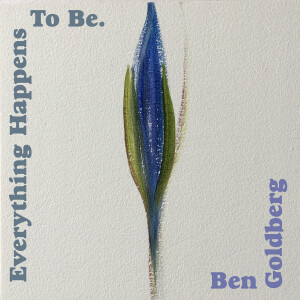 Starting from a base in classical music and klezmer, clarinetist Ben Goldberg has spent about 30 years now finding his own ways of making experimental music within a loose jazz framework. For his latest outing he put together an ensemble with whom he has played, and who have played with each other, in various configurations in recent years. The result is a collection of tunes that mostly balances the melodic with the avant-garde.
Starting from a base in classical music and klezmer, clarinetist Ben Goldberg has spent about 30 years now finding his own ways of making experimental music within a loose jazz framework. For his latest outing he put together an ensemble with whom he has played, and who have played with each other, in various configurations in recent years. The result is a collection of tunes that mostly balances the melodic with the avant-garde.
The quintet here features an unusual front line of clarinet and saxophone —Goldberg on (mostly) B-flat and Ellery Eskelin on tenor sax. The rhythm section’s core are also two players known for their progressive chops, Michael Formanek on bass and drummer Tomas Fujiwara. Mary Halvorson, one of the most experimental of guitarists playing today, fluidly moves back and forth between the rhythm section and the front line, adding lots of texture and color with an array of effects pedals in addition to her keen melodic inventiveness. (Both Halvorson and Fujiwara were members of Formanek’s Ensemble Kolossus for the absorbing large band date The Distance in 2015.)
That unexpected pairing of clarinet and tenor up front is what initially drew me to this release. It jumps right out at you from the very beginning on the opening track “What About.” It’s a long, slow, soulful work that plays with the form of klezmer and maybe even the idea of sevdalinka. Goldberg takes the lead and Eskelin comments or answers in something like counterpoint in the lengthy introductory section – all the while the rhythm section lays down a solid bed of sound. After a skittery brushed snare solo, the clarinet and guitar pick up with an entirely different, sadly sweet melody, playing in unison as the tenor comments, and the drums and bass provide a much more jazz-typical rhythmic accompaniment.
The next three tunes are a great combo of the most accessible, or most traditionally jazz-like. The focus of “21” is a jaunty blues played in mostly straightforward fashion by Goldberg and Eskelin, interrupted and occasionally overwhelmed by intervals of guitar-bass-drums noise. “Fred Hampton,” my favorite, is a bit of beguiling exotica – a tropical melody on the clarinet and sax, mallets on toms, and rhythmic bass, with an overlay of watery effects from Halvorsen’s guitar. I’m assuming it’s a tribute to the eponymous slain Chicago Black Panthers leader, which would account for the overall somber air and much darker textures and colors than you’d normally find in the library music that it resembles. The title track, a languid post-bop ballad, hews pretty closely to traditional structure of melodic statement followed by solo sections. Nice solos all around, and gorgeous textures in the melody sections as guitar, clarinet and sax play off of each other in various combinations. Halvorson’s guitar is heavily phased in her solo section and elsewhere. Pay close attention to Formanek and Fujiwara on this one, they’re really locked in a groove.
Things kind of get increasingly edgy from here on out. “Cold Weather” plays with the form of swing era ballads, with bits of klezmer and post-bop in the mix. Everybody gets a chance to stretch out on the 10-minute “Chorale Type,” which has lots of guitar-clarinet-sax exploration — the trust and intuition these three display in playing swap the lead is immensely gratifying, the kind of things you come to jazz for.
The farthest out they get sonically is on “Tomas Plays The Drums,” on which Goldberg plays a contra alto clarinet like a foghorn in the night. The opening section finds guitar, sax, that deep clarinet and even the bass all more or less playing the same melody but in slightly different ways, backed by a lot of impressive constant soloing from Fujiwara. There’s a point about two minutes in when Halvorson starts a fusion-esque solo and you think it’s going to go one way, but it goes a different way as Halvorson and Eskelin play a skronking duet, which melds into a free improv section with that contra alto clarinet rumbling along with Formanek’s bass. This kind of avant garde free noise fest isn’t my favorite thing to listen to, but I’ll take any opportunity to hear such a lovely deep melifluous instrument as the contra alto; and I love the sections when guitar, sax, clarinet and bass are all dancing around the wandering melody line in ways that seem to combine composed and improvised music, while Fujiwara lays down a constant rain of 32nd notes.
Goldberg is heavily influenced by Thelonius Monk. He says in the bio section of his website:
The music of Thelonious Monk has been central to my education and development. As with the European classical masters, the study of Monk’s music has taught me a lot. The more I play these songs, the more I see that each one contains a lesson – sometimes a lesson in harmony, sometimes melody, sometimes rhythm or phrasing – that forms the living core of the piece.
The playful “To-Ron-To” is obvious in its Monk influence, with tons of harmonic inventiveness and everybody playing their own truth while operating as a tight unit. The date wraps beatifically with a straight rendition of the hymn “Abide With Me,” which I understand is inspired by an early Monk recording as well. Everything Happens To Be. is challenging and rewarding music.
(BAG Production, 2021)
